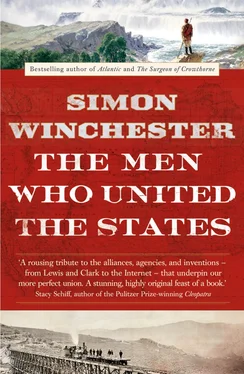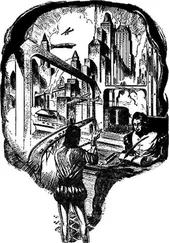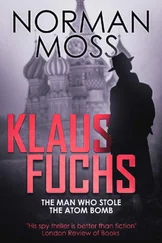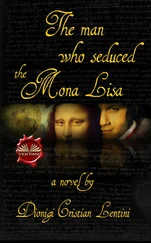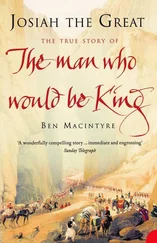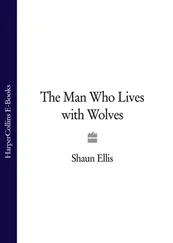The First Big Dig
The Wedded Waters of New York
The Linkman Cometh
That Ol’ Man River
PART IV: WHEN THE AMERICAN STORY WAS FANNED BY FIRE, 1811–1956
May the Roads Rise Up
Rain, Steam, and Speed
The Annihilation of the In-Between
The Immortal Legacy of Crazy Judah
Colonel Eisenhower’s Epiphanic Expedition
The Colossus of Roads
And Then We Looked Up
The Twelve-Week Crossing
PART V: WHEN THE AMERICAN STORY WAS TOLD THROUGH METAL, 1835–TOMORROW
To Go, but Not to Move
The Man Who Tamed the Lightning
The Signal Power of Human Speech
With Power for One and All
Lighting the Corn, Powering the Prairie
The Talk of the Nation
Making Money from Air
Television: The Irresistible Force
The All of Some Knowledge
EPILOGUE
Footnotes
Bibliography
Searchable Terms
Acknowledgments
About the Author
Also by Simon Winchester
About the Publisher
MAPS AND ILLUSTRATIONS
Illustrations noted as “( pd. )” are in the public domain.
1. The five classical elements. ( Lettering by Mrs. Akiko Sato; courtesy of the author )
2. The Point of Beginning, East Liverpool, Ohio. ( Courtesy of the author )
3. The B-2 bomber squadron at Whiteman Air Force Base. ( Courtesy of the US Department of Defense, photograph by SrA Jessica Kachman, June 1998 )
4. William Maclure in New Harmony. ( Painting by Thomas Sully, courtesy of the Academy of Natural Sciences, Ewell Sale Stewart Library, Drexel University )
5. Maclure’s geological map of the United States. ( Courtesy of David Rumsey Map Collection, www.davidrumsey.com )
6. Gouverneur Warren’s 1858 map. ( Courtesy of Derek Hayes )
7. John Wesley Powell. ( Courtesy of the Library of Congress )
8. Steamboat Rock. ( Courtesy of the author )
9. The Grand Canyon of the Yellowstone ( Painting by Thomas Moran, 1893; courtesy of the Smithsonian American Art Museum, Washington, DC/Art Resource, NY )
10. Clarence King in the field. ( Courtesy of the US Geological Survey Photographic Library )
11. Ada Copeland (also known as Mrs. King or Mrs. Todd) with her son Wallace. ( Courtesy of the New York Daily News )
12. The Youghiogheny River. ( Courtesy of the author )
13. A column by “Hercules” in the Genesee Messenger . ( Courtesy of The New-York Historical Society )
14. “Wedding of the Waters” ceremony, New York. ( Copyright 1905, C. Y. Turner )
15. Asian carp. ( Courtesy of Nerissa Michaels )
16. The Chancellor Livingston . ( Courtesy of The New-York Historical Society )
17. Donner Pass. ( pd. )
18. On the 1919 motor convoy. ( Courtesy of the National Archives )
19. The “Good Roads Train.” ( Courtesy of Project Gutenberg )
20. Thomas MacDonald. ( Courtesy of the Library of Congress )
21. “Good Roads Everywhere” map. ( Courtesy of Derek Hayes )
22. Map of the Interstate Highway System. ( Courtesy of Derek Hayes )
23. Opening of the I-94, in Wisconsin. ( Courtesy of the Wisconsin Historical Society )
24. Cal Rodgers. ( Courtesy of Stephen White )
25. Cal Rodgers’s plane. ( Courtesy of Stephen White )
26. Farny’s The Song of the Talking Wire . ( Courtesy of the Taft Museum of Art, Cincinnati )
27. Samuel Morse’s patent, No. 1,647. ( Courtesy of the US Patent Office )
28. Samuel Morse sending the first telegraph message. ( © Bettmann/CORBIS )
29. Telephone wires in New York City. ( Courtesy of Stephen White )
30. Electricity demonstration. ( Courtesy of Stephen White )
31. Nikola Tesla. ( pd. )
32. “PWA Rebuilds the Nation” poster. ( Courtesy of David Rumsey Map Collection, www.davidrumsey.com )
33. Reginald Fessenden and his transmitter lab. ( pd. )
34. Family grouped around a radio receiver. ( Courtesy of Stephen White )
35. Johnny Carson. ( pd. )
36. Joseph Licklider. ( pd. )
37. Vint Cerf. ( Courtesy of Joi Ito, 2007 )
38. Robert Kahn. ( pd. )
39. Google server farm. ( Photograph by Connie Zhou; courtesy of Google )
On Independence Day, July 4, 2011, I swore a solemn oath before a federal judge on the afterdeck of the warship USS Constitution in Boston Harbor, and by doing so I became, after half a century of dreaming, a naturalized American citizen. The following day I acquired my voter’s registration card; a week later I was issued my first American passport, a document on which I have traveled ever since. When I returned to Kennedy Airport after my first trip overseas as an American, I was little prepared for my reaction when the immigration officer remarked with casual warmth, “Welcome home.” I felt almost overwhelmed by at last now being a part of all of this .
The most recent design of an American passport incorporates a series of declarative epigraphs at the top of each visa page. Samuel Adams: “What a glorious morning for our country.” The inscription on the Golden Spike at Promontory Summit in Utah: “May God continue the unity of our country as the railroad unites the two great oceans of the world.” And Jessamyn West’s description of the railway as “A big iron needle stitching the country together.”
But of all the quotations, the one I like most is a paragraph taken from Lyndon Johnson’s inaugural address of January 20, 1965. The nation was at the time still shocked by the tragic shooting of President Kennedy—the event that elevated LBJ to the presidency. The country, still mired in Vietnam, was in a liverish mood, and many more tragedies were yet to come. But Johnson, seeking by his speech to help salve the country’s wounds and to better the temper of the times, spoke in an optimistic vein:
For this is what America is all about. It is the uncrossed desert and the unclimbed ridge. It is the star that is not reached and the harvest sleeping in the unplowed ground. Is our world gone? We say “Farewell.” Is a new world coming? We welcome it—and we will bend it to the hopes of man.
The pages that follow are devoted in large part to those men who, in the overarching interests of welding the nation together, traversed those uncrossed deserts and scaled those unclimbed ridges, offering in their own times and their own ways the promise of a better place and of better times ahead.
PREFACE: THE PURE PHYSICS of UNION
E pluribus unum.
—SINCE 1782, THE MOTTO ON THE OFFICIAL SEAL OF THE UNITED STATES
Early in the crisp small hours of November 7, 2012, a weary but exultant Barack Obama was thanking his countrymen for just handing him a second term as forty-fourth president of the United States. His speech was brief, but it rang with an eloquence that moved well beyond the platitudes of the pitiless election season that had mercifully ended in this culmination just moments before.
It was a speech that spelled out President Obama’s unyieldingly optimistic belief in the future of a country that had allowed him, a young black man, to be invested, now for a second term, as the most powerful human being on the planet. He had been given this role, he said, with a new chance to perfect still further the immense entity that is the American union, more than two centuries after his country had declared its independence from colonial rule.
Читать дальше
